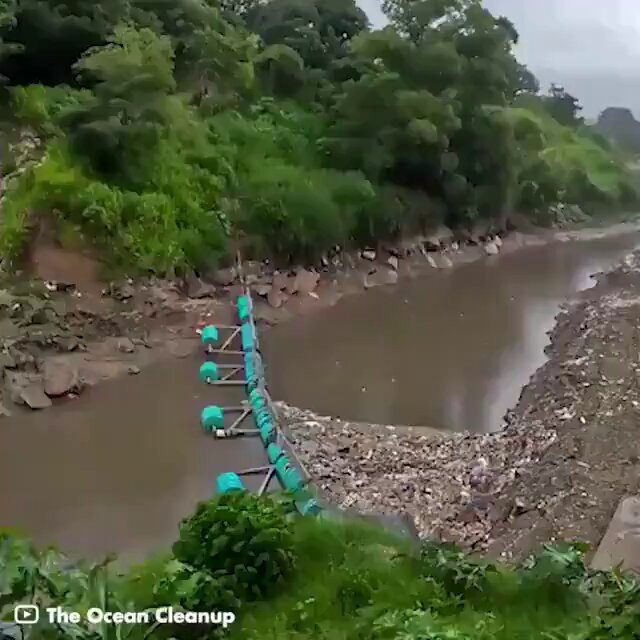As sustainability and environmental conservation become increasingly critical, new technologies are emerging to address urgent ecological challenges. One such innovation is a system that removes millions of pounds of trash from rivers. This marks a significant step in preserving aquatic ecosystems and supporting clean energy.
The Technology Behind River Cleanup
The system, highlighted by @gigadgets_, leverages advanced technology to efficiently remove large quantities of waste from rivers. This initiative is part of a broader movement towards #Sustainability, #Innovation, and #Technology, aiming to create a positive impact on the environment through #Tech4Good and #CleanEnergy solutions.
How It Works
The river cleanup system employs a combination of mechanical and automated processes to collect and remove trash from rivers. The system includes floating barriers that guide debris towards a central collection point, where it is then extracted using conveyor belts and other mechanical devices. This method ensures that even small and hard-to-reach pieces of trash are effectively removed from the water.
Environmental Impact
The impact of this technology on the environment is profound. The system prevents pollution from reaching oceans and harming marine life by removing millions of pounds of trash from rivers. It also boosts the health of aquatic ecosystems, allowing rivers to support diverse wildlife and supply clean water to communities.
Related Innovations in CleanTech
The river cleanup system is part of a larger trend of innovative technologies aimed at environmental conservation. For instance, Marathon Pipe Line (MPL) has installed electric trash skimmers in the Port of Long Beach to reduce pollution and protect biodiversity. These skimmers operate on clean energy and are designed to collect floating debris, further showcasing the potential of technology in addressing environmental challenges.
AI and Automation in Waste Management
Another notable innovation is the use of AI in waste management. Companies like SewerAI are revolutionizing underground infrastructure inspection and management with AI-driven software-as-a-service platforms. SewerAI’s technology automates data capture and defect tagging in sewer inspections, improving efficiency and cost-effectiveness. This approach not only enhances the maintenance of existing infrastructure but also reduces the likelihood of environmental contamination from sewer failures.
Digital Twins for Construction Waste
Sensorita, a company focused on construction waste management, uses digital twin technology to help waste management companies streamline their operations. By providing real-time data on fill levels and locations of waste bins, Sensorita enables companies to optimize pickups and reduce costs. This data-driven approach is crucial for improving the efficiency of waste management in the construction industry, which generates significant amounts of debris.
The Role of Recycling and Circular Economy
Recycling technologies are also playing a vital role in environmental sustainability. For example, Samsara Eco is working on enzymatic recycling to create fossil fuel-free polymer resins from plastic waste. This technology operates at lower temperatures and pressures, significantly reducing the carbon footprint of recycling processes. By recycling a wider range of plastics, including mixed and colored polymers, Samsara Eco aims to divert plastic from landfills and oceans, contributing to a circular economy.
Partnerships and Collaborations
Collaborations between companies and organizations are essential for advancing sustainability initiatives. The Jay Foundation and Satma CE have joined forces to revolutionize waste management by leveraging advanced software platforms for PET bottle recycling. This partnership focuses on real-time visibility, robust reporting capabilities, and end-to-end traceability, promoting transparency and sustainability in waste management.
Conclusion
The integration of innovative technologies in waste management and environmental conservation is paving the way for a cleaner and more sustainable future. From river cleanup systems to AI-driven waste management solutions, these advancements demonstrate the potential of technology to address some of the most pressing environmental challenges. As we continue to develop and implement these technologies, we move closer to achieving a sustainable and healthy planet for future generations.
For more information on related technologies and initiatives, you can explore the following articles:
- Matt Rogers, Nest and Mill co-founder, talks mastering consumer tech at Disrupt 2024
- Direct ocean capture may be the next frontier for carbon removal
- BMW, Ford trial 3D printing automotive parts using recycled fishing nets
Check out more AI tools.
Elevate Guest Experience with RoomGenie
Textify Analytics – Affordable Insights at the Speed of AI
